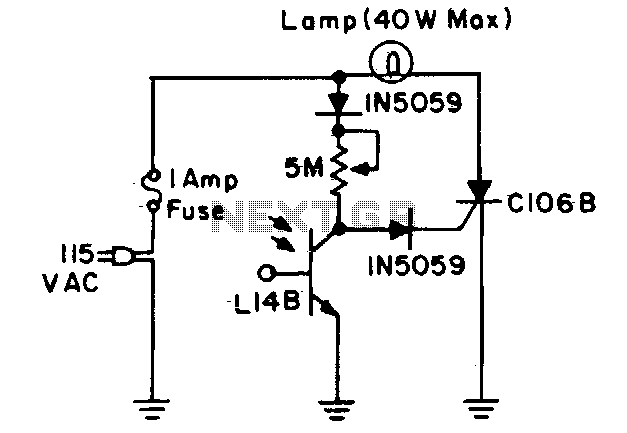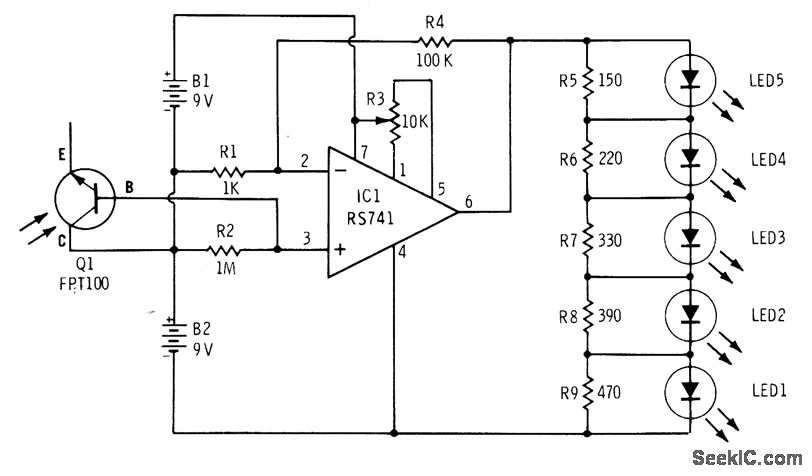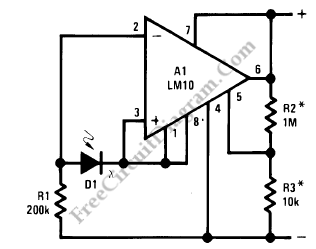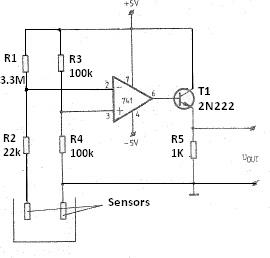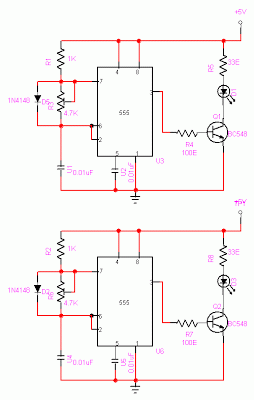
Comparator light sensor
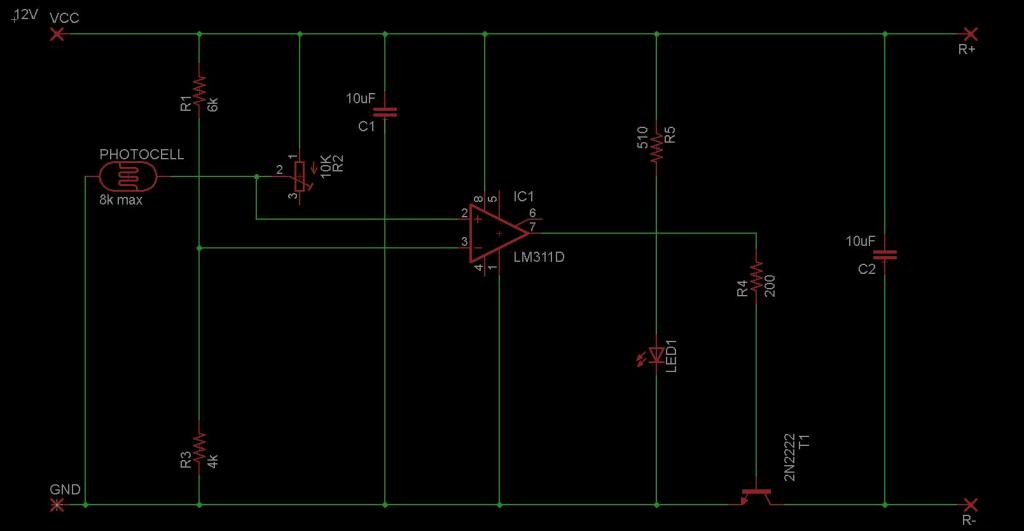
The circuit is designed to sense ambient light levels and activate lights when it is dark. A prototype was successfully built on a breadboard using an LM324 comparator, various resistors, a trimmer resistor, and a photocell. Subsequently, a PCB was designed that replaced the LM324 with an LM311. However, the new circuit does not operate smoothly; a high-pitched hum is heard when light shines on the photocell, and the output voltage is approximately 5.6 volts. When the light is blocked, the humming ceases, and the output rises to the expected 12 volts. The user suspects that oscillation occurs in the presence of light, leading to the hum. Suggestions for improvement include using multiple photocells to sense light from different directions, utilizing a logic AND configuration to reduce false triggers, and ensuring that all conditions are only true during daylight. Additionally, it is recommended to place a 2N222 NPN transistor on the high side of the 12V supply, or to switch to a PNP transistor if a low-side configuration is preferred, with necessary adjustments to the comparator inputs.
The circuit operates based on a light-dependent resistor (photocell) that changes resistance according to the intensity of ambient light. In low-light conditions, the resistance of the photocell increases, allowing the comparator (LM311 in this case) to compare the voltage across the photocell with a reference voltage set by the resistors and trimmer. The output of the comparator switches states based on this comparison, ideally turning on the connected lights when it is dark.
The issue of oscillation and high-frequency noise may stem from the feedback loop or the configuration of the components. When the light is present, the photocell's resistance decreases, potentially causing rapid fluctuations in the output voltage due to insufficient damping in the circuit. This can result in the high-pitched hum observed. To mitigate this, employing multiple photocells oriented in various directions can provide a more stable input to the comparator, effectively reducing the likelihood of false triggering and oscillation.
Using a logic AND configuration would require each photocell to be connected to its own comparator, with their outputs combined to ensure that the lights only turn on when all conditions indicate darkness. This approach enhances reliability by ensuring that the system does not activate under false light conditions.
Regarding the transistor configuration, placing the 2N222 NPN transistor on the high side allows for better control of the load when the output from the comparator is high. If a low-side configuration is preferred, switching to a PNP transistor is advisable, but this requires a corresponding adjustment to the inputs of the comparator to ensure proper operation.
In summary, the circuit can be improved by addressing the oscillation issue through component configuration and by utilizing multiple sensors to enhance reliability in detecting ambient light levels. These adjustments will likely lead to a more stable and effective light-sensing and activation system.Sense the amount of ambient light and switch the lights on when it was dark out. I was successful in building one on a bread board that used an lm324 (its the only comparator radioshack had) some resistors a trimmer resistor and a photocell. So I went and designed a board using the same basic circuit but I replaced the lm324 with a lm311 and made a board.
However it dose not work smoothly when I have light shining on the photocell I hear a high pitched hum and i`m getting around 5. 6volts on the output when I block the light the humming goes away and the output goes up to 12v like it should. Ii am not sure how to fix it. i do not own an oscilloscope so i cant check but i`m guessing its oscillating when there is light and that`s why i hear the humming Any input on how I could fix this would be appreciated.
Thank you. use multiple photocell that sense every different direction and use logic AND to turn the light ON, the probability of hum and false OFF will be lower. the only condition thats surefire to trigger all condition TRUE is during the daylight. 2) put the 2N222 NPN on high 12V side, or change to PNP if you want to stick to that low side config (but you`ll also need to switch comparator +ve and -ve input), NPN works better on high side and PNP on low side (you got them backward in your schematics).
thats what my experience tells from my unproven experimenting. 🔗 External reference
The circuit operates based on a light-dependent resistor (photocell) that changes resistance according to the intensity of ambient light. In low-light conditions, the resistance of the photocell increases, allowing the comparator (LM311 in this case) to compare the voltage across the photocell with a reference voltage set by the resistors and trimmer. The output of the comparator switches states based on this comparison, ideally turning on the connected lights when it is dark.
The issue of oscillation and high-frequency noise may stem from the feedback loop or the configuration of the components. When the light is present, the photocell's resistance decreases, potentially causing rapid fluctuations in the output voltage due to insufficient damping in the circuit. This can result in the high-pitched hum observed. To mitigate this, employing multiple photocells oriented in various directions can provide a more stable input to the comparator, effectively reducing the likelihood of false triggering and oscillation.
Using a logic AND configuration would require each photocell to be connected to its own comparator, with their outputs combined to ensure that the lights only turn on when all conditions indicate darkness. This approach enhances reliability by ensuring that the system does not activate under false light conditions.
Regarding the transistor configuration, placing the 2N222 NPN transistor on the high side allows for better control of the load when the output from the comparator is high. If a low-side configuration is preferred, switching to a PNP transistor is advisable, but this requires a corresponding adjustment to the inputs of the comparator to ensure proper operation.
In summary, the circuit can be improved by addressing the oscillation issue through component configuration and by utilizing multiple sensors to enhance reliability in detecting ambient light levels. These adjustments will likely lead to a more stable and effective light-sensing and activation system.Sense the amount of ambient light and switch the lights on when it was dark out. I was successful in building one on a bread board that used an lm324 (its the only comparator radioshack had) some resistors a trimmer resistor and a photocell. So I went and designed a board using the same basic circuit but I replaced the lm324 with a lm311 and made a board.
However it dose not work smoothly when I have light shining on the photocell I hear a high pitched hum and i`m getting around 5. 6volts on the output when I block the light the humming goes away and the output goes up to 12v like it should. Ii am not sure how to fix it. i do not own an oscilloscope so i cant check but i`m guessing its oscillating when there is light and that`s why i hear the humming Any input on how I could fix this would be appreciated.
Thank you. use multiple photocell that sense every different direction and use logic AND to turn the light ON, the probability of hum and false OFF will be lower. the only condition thats surefire to trigger all condition TRUE is during the daylight. 2) put the 2N222 NPN on high 12V side, or change to PNP if you want to stick to that low side config (but you`ll also need to switch comparator +ve and -ve input), NPN works better on high side and PNP on low side (you got them backward in your schematics).
thats what my experience tells from my unproven experimenting. 🔗 External reference

